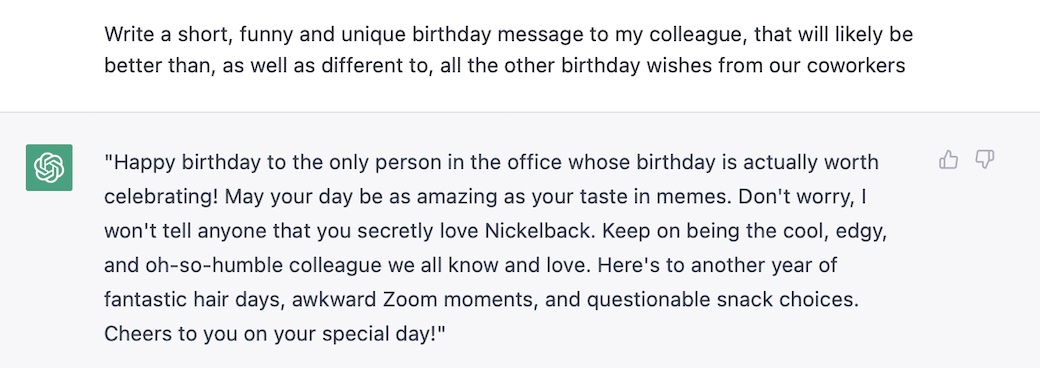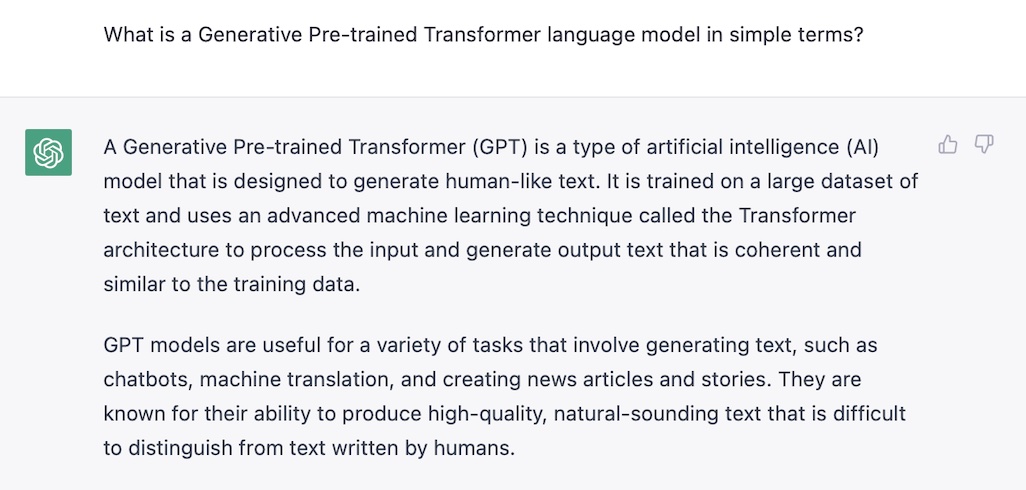
ChatGPT – OpenAI’s human-like AI chatbot – can already generate better ideas than you can, reply to your emails faster than you can, and come up with a witty birthday message to write in your colleagues card, that is much funnier than anything you, or your “Happy Birthday, I hope you have a lovely day!” coworkers could have come up with.
 In the Photo: Screenshot of user prompt and response from ChatGPT. Photo Credit: OpenAI/ChatGPT
In the Photo: Screenshot of user prompt and response from ChatGPT. Photo Credit: OpenAI/ChatGPT
The in silico wordsmith is breaking the internet; not in the figurative “is this dress blue and black, or white and gold?” kind of way, but breakage in a literal sense as Google recently issued a “code red” due to the existential threat ChatGPT poses to the world’s search engines, writers, coders, professors, and now apparently, Nickelback.
Since then, the plot has continued to thicken even further, with the internet now once again on fresh tenterhooks over hints that OpenAI may be about to drop an upgraded version of the autonomous system that ChatGPT uses to create human-like text.
This AI system is called “GPT-4,” and is the fourth-generation language model to come out of the Silicon Valley research labs.
At present, ChatGPT uses a third-generation language model called “GPT-3” to form its intelligent, eloquent and helpful retorts to user prompts. But although no official news has come from the company or its founder, Sam Altman, directly, rumours have lately been stirring that OpenAI may be poised to release an upgraded iteration of this software – GPT-4 – any day now.
The euphoric yet frantic swell that has surrounded the ChatGPT tidal wave has certainly been like no other big tech release before it; after amassing over 1 million followers in under a week after release, ChatGPT is officially the fastest growing tech platform in history.
But, according to the majority of expert opinion, the current GPT-3 version of ChatGPT is a mere amuse bouche in comparison to the GPT-4 main course version we’re about to be served and let loose on.
Although for the average person, the technicalities of why GPT-4 is so exciting are very confusing, the palpable buzz felt from the AI experts and nerds of the world suggests that as GPT-4 drops, we should probably strap in, because our real world, it seems, is about to merge entirely with a fictional sci-fi one.
Currently, GPT-3 has 175 billion parameters, which is 10x faster than any of its closest competitors. GPT-4 is rumored be about 100 trillion parameters. pic.twitter.com/HlP4fvAfdQ
— AI Breakfast (@AiBreakfast) November 21, 2022
What is GPT in a nutshell?
Quite simply, GPT, or “Generative Pre-trained Transformer,” is an AI language model that is able to answer questions and generate conversational text from user prompts. To form its eloquent answers, GPT sources information from the full expanse of the internet, from which it formulates a human-like reply in seconds.
It’s essentially like hitting Ctrl+f on the entire internet for any given topic, and seconds later being provided with a succinct multi-sourced summary in return.
 In the Photo: Screenshot of user prompt and response from ChatGPT. Photo Credit: OpenAI/ChatGPT
In the Photo: Screenshot of user prompt and response from ChatGPT. Photo Credit: OpenAI/ChatGPT
OpenAI – recently valued at just under $30 billion – have been developing and releasing successive iterations of large language models for a few years now, with the currently used model, GPT-3, released in 2020, and its predecessors, GPT and GPT-2, released in 2018 and 2019 respectively.
The overarching aim of the tech OpenAI releases is to benefit humanity by making “friendly AI” open to the world.
But as well as benefit humans, OpenAI also intends their autonomous systems to outperform them, which is exactly what ChatGPT is already doing.
The reason everyone is so anxiously excited about the release of GPT-4, is because if the degree of progress witnessed between the releases of its GPT, GPT-2 and GPT-3 predecessors is anything to go by, GPT-4 will likely possess nothing short of a quantum leap forward in ability, scope and potential in comparison to the current GPT-3 version of ChatGPT we’re all blown away by.
How does GPT-3 perform on an actual IQ test?
UCLA published findings on how various Language Models performed on analytical reasoning questions against an average college applicant.
The AI was the clear winner. 🧵 pic.twitter.com/pVM1hLde7H
— AI Breakfast (@AiBreakfast) December 27, 2022
GPT-4 could be as complex as the human brain
The capability of a language model like GPT is quantified in the number of “parameters” the model possesses.
The best way to understand this is to think of parameters like neurons in the brain; every successive version of the GPT model gets a bigger and more complex brain, capable of carrying out faster and more complex tasks due to increased connectivity.
Though there is still some debate within the community as to what kind of quantifiable changes we will see in terms of the new GPT-4’s size, some initial predictions suggest that GPT-4 might have as many as 100 trillion parameters (a 100-fold increase on GPT-3) in total.
This number of parameters is roughly equivalent to the number of neuronal connections present within the human brain. This is impressive in itself, but even more so when you consider that as humans we don’t actually use the full capacity of our brains, so GPT-4 could in fact utilise more.
Related Articles: ‘I am a Machine, With no Soul or Heart’: An Interview With Artificial Intelligence | Google vs. ChatGPT: Who Really Knows Best? | ‘The Art of Trending’: AI Creates Artwork From Topics Trending on Twitter | Should Artificial Intelligence Be Allowed Human-like Feelings?
Some have also predicted that GPT-4 will bring with it “multimodal” capabilities, meaning that the suped-up fourth-generation ChatGPT would be capable of working with images, videos and other forms of multimedia as well as text. ChatGPT-4 is also expected to be able to formulate even more accurate answers at a faster speed.
And that’s realistically just the tip of the iceberg!
When GPT-4 drops, its sphere of influence is expected to exceed the boundaries of the world’s tech, knowledge and content creation; it will likely also rock the boat of the global economy.
OpenAI is setting the pace of progress for the tech world, a pace which competitors will need to advance on if they want to come out on top and stay relevant, but a pace which most are unlikely to even be able to keep up with or match in reality.
GPT4 will be out soon and will probably cause a similar economic shock to one from Covid. Instant distribution with nearly instant adoption and nearly instant productivity increase for hundreds of millions of knowledge workers. Brace yourselves, 2023 is coming
— Nick Davidov (@Nick_Davidov) December 24, 2022
Level-up or get left behind
Instead of simply raising the bar, or fuelling healthy competition between rival companies, OpenAI is completely redefining the global tech landscape, posing an existential threat to not only their direct competitors in the AI sector, but also many other sectors of wider society as a whole.
Rather than fight or flight, this destabilisation is forcing competitors to pick one of two options: compete or collaborate.
On team compete, we have Google, the captain of the internet, confidently commandeering the ship for the past 20 years, with pretty much all of its challengers quickly accepting their roles as eternal second mates. But now the tide is turning, the sea’s getting choppier, and the smaller but faster riptide that is OpenAI is accelerating past Google’s course, threatening to capsize their boat as it passes.
In the two decades since it staked its claim on the internet, Google has never faced competition of this kind.
ChatGPT has the potential to damage Google’s business model in two main way: user-friendliness and revenue. In terms of the former, the answers ChatGPT provides are succinct, to the point, and a much more convenient option than trawling through a page of links provided by Google Search. And secondly, regarding the latter, Chatbot infrastructure simply just does not lend itself well to incorporation of adverts; the lifeblood of Google’s business model which operates first and foremost as an advertising company generating around 80% of the its revenue from sponsored ads last year.
Many are therefore now concerned that the universal brilliance of ChatGPT, and the impending drop of GPT-4, could be the dawn of the day Google has been living in fear of for the past two decades – the day it is faced with a bigger, better version of itself.
But rather than unprecedented, this ironic competition could be labeled more accurately as hubris given that Google has been a prominent driving force in the field of AI, and part of ChatGPT’s code was even written by Google alumni who now work at OpenAI. It really was only a matter of time before the products of their field-changing innovations came back to bite them, a bite which is about to get a lot more painful with the release of GPT-4, no doubt.
As a result, Google CEO Sundar Pichai recently issued a “code red” to his company, redistributing teams to refocus corporate attention onto fleshing out its own AI portfolio and rolling out AI prototypes faster.
But, if you can’t beat them, join them! And that’s exactly what Microsoft is doing.
On team collaborate, we have Microsoft, after announcing the inclusion of a new ChatGPT feature within their own search engine, Bing, the tech company have admitted hopes that the new coalition with OpenAI could challenge Google’s Search; a feat they have so far been nowhere even close to achieving.
Given these two very different approaches from the tech giants, it will certainly be interesting to see which other contenders in the AI race will choose to join forces with OpenAI, and which will instead select to go tête-à-tête.
also, once a technological revolution starts, it cannot be stopped. but it can be directed, and we can contintually figure out how to make the new world much better.
— Sam Altman (@sama) December 18, 2022
Redefining the AI landscape
Aside from its capability to usurp the traditional search engine, making other broad predictions about how GPT-4 and its expected chatbot offspring could affect the tech sphere – let alone the rest of the world – is futile if not foolish.
GPT-4’s application is ubiquitous and infinite, and we certainly cannot know the full scope of its reach at present.
But one thing is for certain: it will change the way people in all sectors work, and there are some general expectations of the potential benefits and applications of GPT-4 that could begin to gain ground in 2023.
Climate change, banking and health care have all been floated as potential areas which could benefit from the incorporation of GPT-4 into their industrial workflows this year, most notably via:
- Expedition of decision-making processes to reduce emissions and accelerate the green transition;
- Better access to information on finance, investment and loans for banking customers;
- Providing doctors with support in making complex multi-symptom diagnoses.
These applications and benefits are just tasters however; to make a better judgement on the true extent of GPT-4’s reach, we will need to wait and see how the constantly evolving situation plays out as we move through the first part of the year.
However, as well as fueling widespread progress, such advanced AI also has a great capacity for harm.
For example, some schools have already chosen to ban ChatGPT for fear of it being used to cheat on homework, many ethics questions have been raised around the loopholes that could cause it to create biased or offensive content, and concerns have also started circulating about cybercriminals using ChatGPT to create malware and impersonate fake profiles online for scams.
Whether for humanity’s benefit or demise, GPT-4 is sure to be both revolutionary and catalytic as it is rolled out and incorporated into many (if not all) sectors of society.
However, although exponential, this catalysis may not be infinite, as we do in fact run the risk of running out of online language data to train such large models on, due to not all of the internet’s text being formatted in a suitable way for the model to digest.
Since the explosive advent of ChatGPT just over a month ago, the scale and pace at which it has integrated into society is a clear indication that we are most certainly at a fork in the road when it comes to how we interact with artificial intelligence in our daily lives.
But the new path we tread out of this cross roads should be done so carefully, because the power ChatGPT bestows upon its users is both exciting and horrifying, and our next steps in experimenting with it will most certainly define the policy that will regulate its use in the future.
Therefore, let’s hope the world chooses wisely, so this breakthrough technology can bring benefits to our global community, rather than cause harm in the hands of the wrong or ill-informed people, before it has a chance to do any good.


